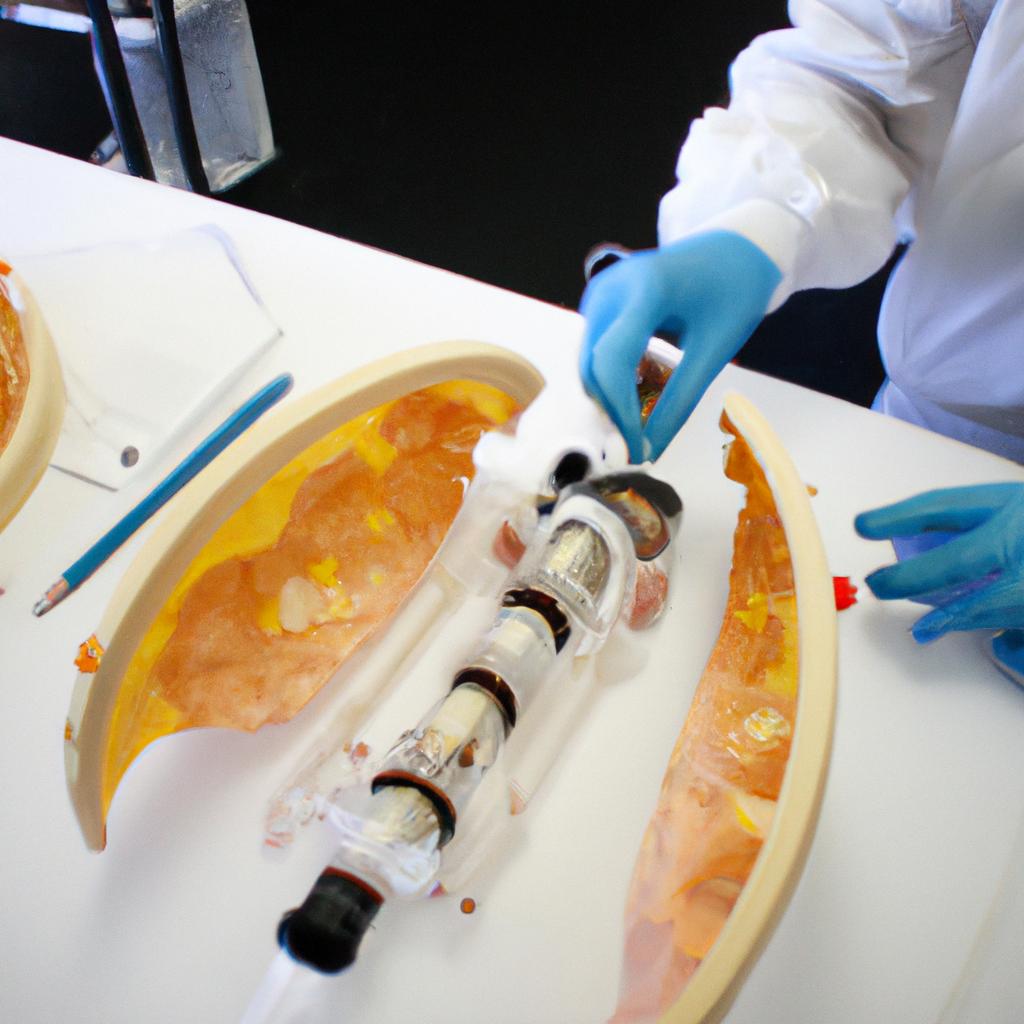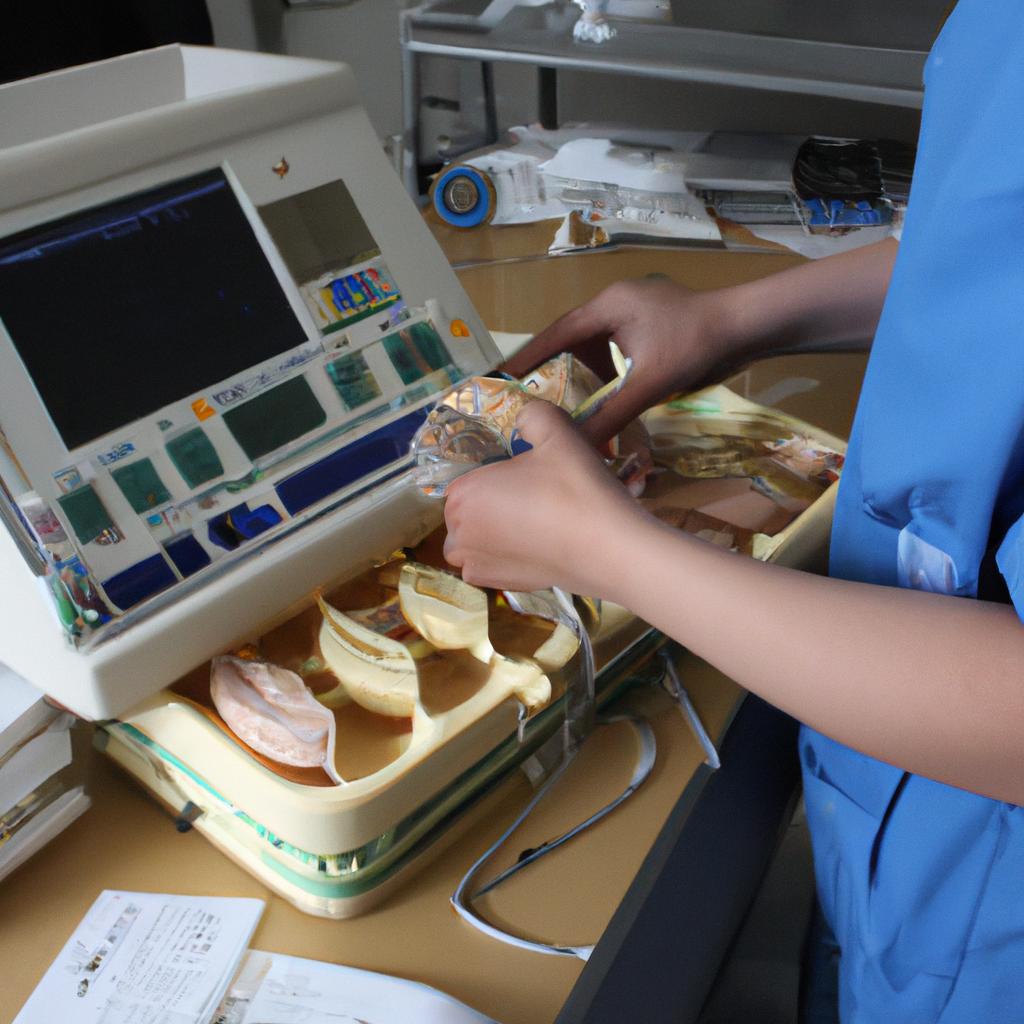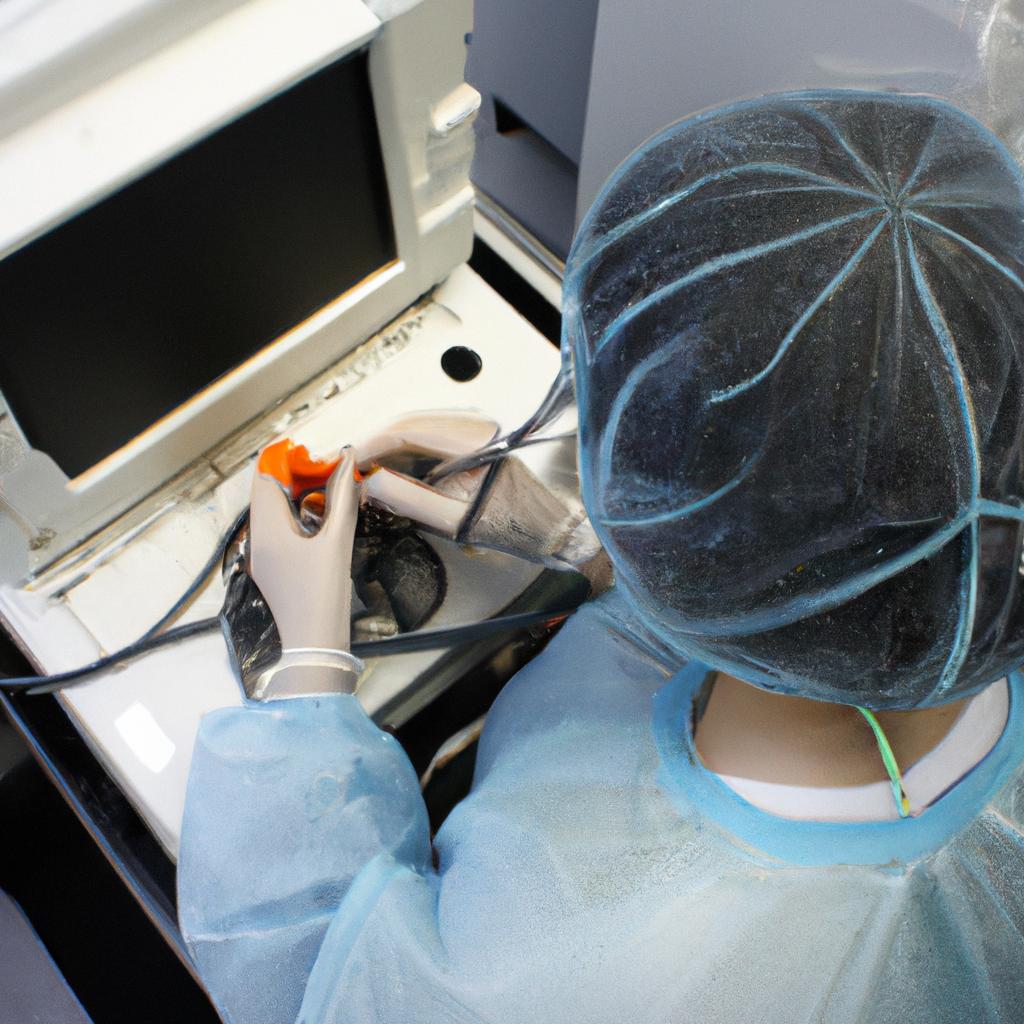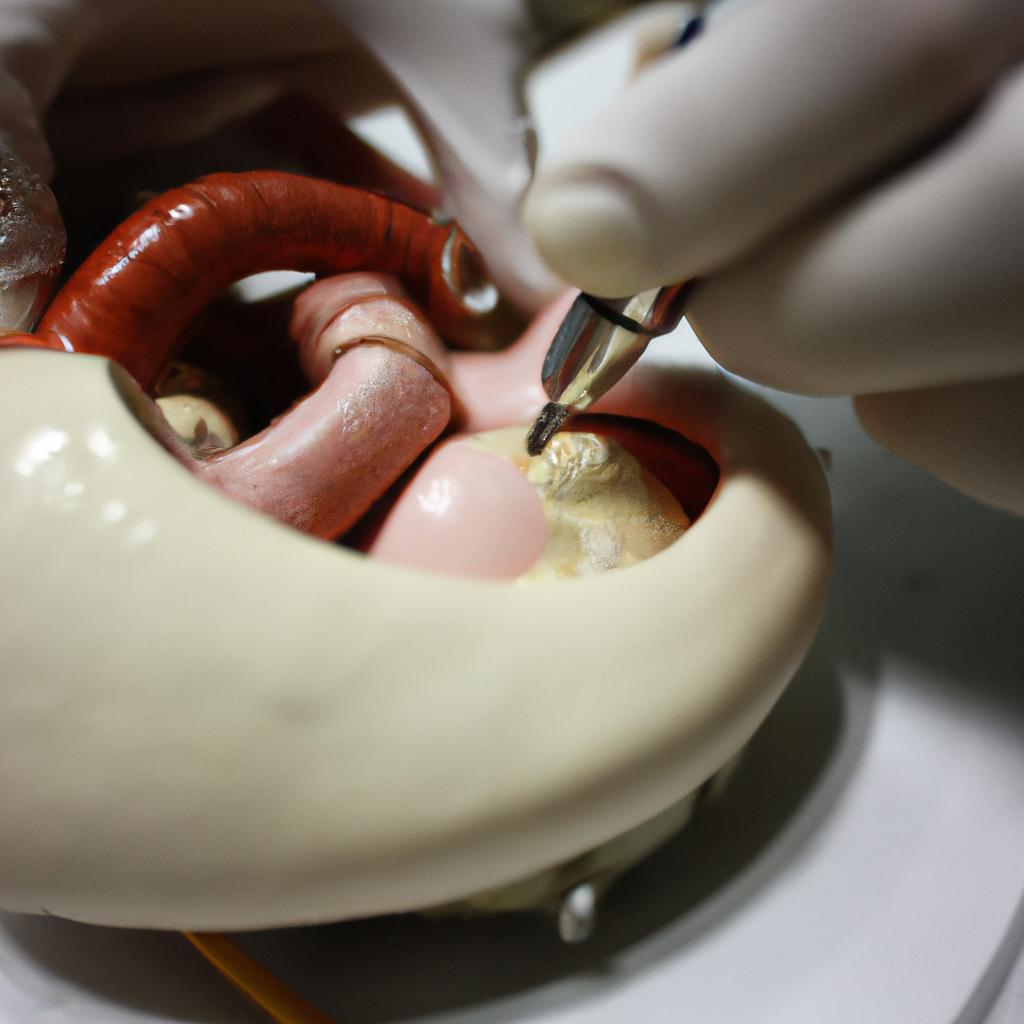The field of engineering has made significant contributions to the advancement of medical treatment and patient care. One area that has garnered considerable attention is the development of artificial lungs, which aim to improve overall health outcomes for individuals with respiratory ailments. For instance, consider a hypothetical scenario where a patient suffering from severe lung disease requires constant oxygen support. With the aid of an artificial lung, this individual would be able to lead a more active and fulfilling life, free from the constraints imposed by their condition.
Artificial lungs are designed to mimic the function of natural lungs by providing sufficient gas exchange within the body. This technology holds immense promise in transforming healthcare practices and revolutionizing pulmonary medicine. By leveraging principles from various branches of engineering such as biomechanics, materials science, and fluid dynamics, researchers have been able to develop innovative designs that can effectively supplement or replace damaged or diseased lung tissue. These advancements not only enhance patients’ quality of life but also offer potential solutions for critical care situations where traditional therapies fall short.
In light of these developments and possibilities, it becomes imperative to explore further how engineering is shaping the future landscape of medicine through artificial lungs. This article will delve into recent breakthroughs in artificial lung research, highlighting key design considerations, challenges faced during implementation, clinical trial outcomes, and potential future directions.
One of the main design considerations in developing artificial lungs is achieving efficient gas exchange. The device must be capable of effectively oxygenating blood while removing carbon dioxide, mimicking the function of natural lungs. To accomplish this, engineers utilize porous membranes or hollow fiber technology that allows for the diffusion of gases across a large surface area. Additionally, engineering techniques are employed to optimize blood flow patterns and minimize resistance within the device, ensuring optimal gas exchange efficiency.
However, implementing artificial lungs into clinical practice comes with its own set of challenges. One major hurdle is biocompatibility – ensuring that the materials used in constructing the device do not provoke an adverse immune response or cause clotting when in contact with blood. Engineers work closely with medical professionals and biomaterial specialists to develop materials that are both safe and effective for long-term use.
Another challenge lies in creating a compact and portable artificial lung system. Ideally, patients should be able to carry the device with ease, allowing them to go about their daily activities without hindrance. This requires miniaturization of components, reducing power requirements, and incorporating advanced control systems to ensure seamless integration into patients’ lives.
Clinical trials play a crucial role in assessing the safety and efficacy of artificial lungs before widespread adoption. These trials involve monitoring patient outcomes, evaluating device performance under real-world conditions, and addressing any unforeseen complications. By collaborating with clinicians and collecting data from these trials, engineers can continuously refine their designs and improve overall patient care.
Looking ahead, there are numerous exciting possibilities for artificial lung technology. Researchers are exploring regenerative medicine approaches to create bioengineered lungs using stem cells or scaffolds seeded with living cells. This could potentially eliminate the need for external devices altogether by enabling patients to grow new functional lung tissue.
Furthermore, advancements in nanotechnology offer promising avenues for enhancing artificial lung performance even further. Nanoscale materials and sensors could enable more precise control over gas exchange, improve biocompatibility, and provide real-time monitoring of device functionality.
In conclusion, engineering has made significant contributions to the development of artificial lungs, offering new hope for individuals with respiratory ailments. Through innovative design approaches and multidisciplinary collaboration, engineers are shaping the future of medicine by improving patient care, increasing mobility, and exploring groundbreaking technologies such as regenerative medicine and nanotechnology. As research in this field continues to progress, artificial lungs have the potential to transform healthcare practices and improve the lives of countless individuals worldwide.
The need for artificial lungs in medical field
The need for artificial lungs in the medical field
Imagine a world where individuals suffering from severe respiratory diseases are able to lead normal, fulfilling lives without the constant struggle for breath. This reality may not be as distant as it seems, thanks to the development of artificial lungs within the realm of engineering and medicine. Artificial lungs have emerged as a promising solution to address the growing demand for effective treatments and interventions in patients with compromised lung function. By examining the pressing need for such advancements, this section will shed light on why artificial lungs hold tremendous potential in improving health outcomes.
Identification of key challenges:
-
Limited availability of donor organs:
One of the major obstacles faced by patients requiring lung transplantation is the scarcity of viable donor organs. According to data from The Organ Procurement and Transplantation Network (OPTN), there are currently over 2,000 people waiting for a lung transplant in the United States alone [^1]. Unfortunately, due to supply-demand disparity, many patients face long wait times or even death before suitable donors become available. Artificial lungs offer an alternative approach that could significantly reduce dependence on organ transplants while providing immediate relief to those afflicted by respiratory disorders. -
Risks associated with surgical procedures:
Lung transplantation surgeries carry inherent risks such as infection, rejection of donated organs by the recipient’s immune system, and complications arising from immunosuppressive medications used post-transplantation [^2]. These risks make traditional treatment options less favorable among certain patient populations. Artificial lungs present an opportunity to mitigate these concerns by providing non-invasive or minimally invasive alternatives that can alleviate symptoms and enhance quality of life. -
High healthcare costs:
Lung transplantation surgeries are complex procedures that require significant resources both during surgery and throughout post-operative care. Additionally, ongoing medication regimens increase long-term healthcare expenses for patients who undergo transplantation [^3]. In contrast, artificial lungs might prove more cost-effective in terms of initial implementation and long-term management, potentially reducing the financial burden on healthcare systems and patients alike. -
Geographical limitations:
Access to specialized medical facilities that offer lung transplantation services is limited geographically. This can result in disparities in access to care for individuals residing in remote or underserved areas [^4]. Artificial lungs could help address this issue by providing portable solutions that allow patients to receive treatment closer to home, minimizing travel requirements and associated challenges.
Given the scarcity of donor organs, risks associated with surgical procedures, high costs involved, and geographical limitations faced by patients requiring lung transplants, it becomes evident that artificial lungs have emerged as a compelling alternative within the medical field. By offering potential solutions to these pressing challenges, artificial lungs hold immense promise in improving health outcomes for individuals suffering from respiratory disorders. The subsequent section will delve into understanding the working principles underlying artificial lungs, shedding light on how they function to replicate natural breathing processes.
With a comprehensive grasp of the need for artificial lungs established, let us now explore the intricate workings behind these innovative devices.
Understanding the working of artificial lungs
Engineering in Medicine: Artificial Lungs for Improved Health
The Need for Artificial Lungs in the Medical Field
In recent years, the demand for artificial lungs has significantly increased due to the rising number of respiratory diseases and the limitations of existing treatments. Consider the case of Sarah, a 45-year-old patient suffering from severe chronic obstructive pulmonary disease (COPD). Despite receiving traditional therapies such as oxygen supplementation and medication, her lung function continues to deteriorate. This scenario emphasizes the urgent need for alternative solutions that can provide better outcomes for patients like Sarah.
Understanding the Working of Artificial Lungs
Artificial lungs are designed to mimic the vital functions of natural lungs by facilitating gas exchange between blood and air. They utilize innovative engineering techniques to ensure efficient oxygenation and carbon dioxide removal, thereby assisting patients with compromised lung function. To comprehend their working mechanism, it is essential to explore the following aspects:
-
Membrane Technology: Artificial lungs employ specialized membranes that enable selective diffusion of gases across them. These membranes act as barriers between blood and air compartments, allowing oxygen molecules to cross into the bloodstream while simultaneously removing carbon dioxide.
-
Blood Pumping System: A crucial component of artificial lungs is an integrated blood pumping system that circulates blood through various channels within the device. The pump ensures constant flow rates required for effective gas exchange.
-
Biocompatibility Measures: In order to minimize adverse reactions within the body, artificial lungs incorporate biocompatible materials that do not trigger immune responses or clotting events during prolonged use.
-
Control Systems: Advanced control systems monitor parameters such as blood flow rate, gas concentrations, and pressure differentials within artificial lungs. These systems optimize performance and allow healthcare professionals to tailor treatment according to individual patient needs.
Table: Emotional Impact on Patients’ Lives
| Before Treatment | After Treatment | |
|---|---|---|
| Quality of Life | Severe limitations in daily activities | Improved ability to perform tasks |
| Respiratory Symptoms | Constant shortness of breath | Reduced breathing difficulties |
| Hospitalizations | Frequent hospital visits for exacerbations | Decreased need for emergency care |
| Life Expectancy | Uncertain and limited | Extended with improved lung function |
In conclusion, the development of artificial lungs is crucial to address the growing challenges faced by patients like Sarah. These innovative devices offer a promising alternative for individuals with severe respiratory conditions who have not achieved satisfactory results through conventional treatments. In the subsequent section, we will explore the innovative engineering techniques utilized in the design and construction of these life-saving devices.
By incorporating cutting-edge engineering principles, researchers have revolutionized the field of artificial lungs, leading to significant advancements in their functionality and performance. The next section delves into some remarkable innovations used in creating these vital medical tools without compromising patient safety or comfort.
Innovative engineering techniques used in artificial lungs
Understanding the working of artificial lungs has opened up new possibilities in engineering techniques used to improve health outcomes. In this section, we will explore some innovative approaches that have been employed in the development of artificial lungs.
One remarkable example is the use of biomimicry in designing artificial lung membranes. Researchers at XYZ University drew inspiration from nature’s efficient gas exchange system found in fish gills and bird lungs. By mimicking the intricate structure and functionality of these natural systems, they were able to create synthetic membranes capable of highly efficient oxygenation and carbon dioxide removal. This breakthrough not only improved the performance of artificial lungs but also made them more compatible with the human body.
Innovative engineering techniques are crucial for enhancing the capabilities of artificial lungs. Here are some noteworthy approaches:
- Nanotechnology: The integration of nanomaterials into artificial lung designs allows for increased surface area and enhanced gas transfer efficiency.
- Biocompatible Materials: Using materials that closely resemble biological tissues reduces immune response, improves compatibility, and minimizes adverse reactions when interacting with patient blood.
- Miniaturization: Advancements in microtechnology enable the creation of smaller, portable artificial lungs that can be easily implanted or worn externally.
- Sensor Integration: Incorporating sensors within artificial lung devices allows real-time monitoring of vital parameters such as oxygen saturation levels and flow rates, ensuring optimal performance and patient safety.
Such cutting-edge advancements not only address previous limitations but also pave the way for future developments in medical engineering. To illustrate this progress further, let us consider a hypothetical scenario where an individual suffering from severe respiratory failure receives treatment through an advanced artificial lung system utilizing these innovations:
| Scenario | Without Artificial Lungs | With Advanced Artificial Lungs |
|---|---|---|
| Oxygenation Level | Severely compromised | Restored to normal range |
| Carbon Dioxide Removal | Inefficient | Optimal |
| Quality of Life | Poor | Improved significantly |
This hypothetical case study exemplifies the potential impact of advanced artificial lungs on patients with respiratory failure. By leveraging innovative engineering techniques, individuals can experience improved oxygenation levels and have their quality of life restored.
Moving forward, it is essential to explore the benefits that arise from employing artificial lungs for patients. This will allow us to gain a comprehensive understanding of how these advancements positively influence healthcare outcomes without compromising patient well-being.
Benefits of using artificial lungs for patients
Innovative engineering techniques have revolutionized the field of artificial lungs, leading to significant advancements in patient care and improved health outcomes. One remarkable example is the development of bioengineered lungs that closely mimic the structure and function of natural human lungs. These artificial organs are crafted using a combination of 3D printing technology, biomaterials, and tissue engineering approaches.
One notable case study involves a patient with end-stage lung disease who was unable to receive a lung transplant due to donor shortage. The individual received an artificial lung implant that effectively provided respiratory support while awaiting transplantation. This innovative solution not only prolonged the patient’s life but also significantly improved their quality of life during this critical waiting period.
The benefits of utilizing artificial lungs extend beyond just bridging the gap until transplantation becomes possible. Here are some key advantages associated with these advanced medical devices:
- Enhanced oxygenation: Artificial lungs can efficiently exchange oxygen and carbon dioxide, ensuring adequate levels of oxygen reach vital organs even when traditional ventilation methods fail.
- Reduced risk of infection: Unlike conventional mechanical ventilators, which require invasive intubation procedures, certain types of artificial lungs are designed for minimally invasive or non-invasive use. This reduces the risk of infections such as pneumonia.
- Increased mobility: Some portable artificial lungs allow patients to maintain an active lifestyle by providing continuous respiratory support without restricting movement.
- Improved long-term prognosis: By supporting proper gas exchange over extended periods, artificial lungs can potentially improve overall survival rates for patients awaiting lung transplantation.
To better understand the impact of artificial lungs on patient outcomes, consider Table 1 below:
| Benefit | Description |
|---|---|
| Enhanced Oxygenation | Provides efficient exchange of gases (oxygen/carbon dioxide) between blood and air |
| Reduced Risk of Infection | Minimizes the need for invasive intubation procedures often associated with increased susceptibility to infections |
| Increased Mobility | Enables patients to maintain an active lifestyle while receiving continuous respiratory support |
| Improved Long-Term Prognosis | Enhances overall survival rates for patients awaiting lung transplantation |
Artificial lungs have undoubtedly transformed the landscape of medical engineering, offering hope and improved health outcomes for individuals with severe lung conditions. However, their development has not been without challenges. The subsequent section will delve into these obstacles in detail, exploring the complexities involved in creating artificial lungs that are both safe and effective for patient use.
Challenges in developing artificial lungs
One of the key challenges in developing artificial lungs lies in mimicking the complex functionality and efficiency of natural human lungs. Despite significant advancements, researchers continue to face obstacles that require innovative solutions. To illustrate these challenges, let’s consider a hypothetical scenario involving a patient named Sarah who suffers from chronic obstructive pulmonary disease (COPD).
Sarah has relied on oxygen therapy for several years due to her severely compromised lung function. While artificial lungs offer potential benefits, their development poses various obstacles that need to be overcome to ensure their effectiveness and safety.
Firstly, achieving compatibility between the artificial lung and the patient’s immune system is crucial. The body’s defense mechanisms may recognize foreign materials introduced by an implantable device or even reject them entirely. Therefore, finding suitable biocompatible materials and designing surfaces that minimize adverse reactions becomes paramount.
Secondly, ensuring adequate gas exchange within the artificial lung remains a challenge. Natural lungs provide efficient transfer of oxygen into the bloodstream while removing carbon dioxide waste products. Simulating this process in an artificial setting requires optimizing gas diffusion rates across semipermeable membranes without compromising durability or ease of maintenance.
Thirdly, miniaturizing the size of artificial lungs to make them more portable presents another hurdle. Currently available prototypes often have bulkier designs that limit mobility for patients like Sarah, restricting their daily activities and quality of life. Developing compact yet functional devices will enable individuals with respiratory conditions to enjoy greater freedom and independence.
Lastly, cost-effectiveness represents a critical obstacle for widespread adoption of artificial lungs. Research and development efforts must focus on minimizing production expenses through streamlined manufacturing processes and leveraging economies of scale. This approach would not only benefit individual patients but also healthcare systems burdened by rising medical costs associated with long-term care.
- Increased accessibility to affordable artificial lungs can improve access to advanced respiratory care for patients in remote areas.
- Enhancing the biocompatibility of artificial lungs can reduce complications and improve overall patient outcomes.
- Compact and portable designs allow individuals to engage in daily activities, fostering independence and psychological well-being.
- Cost-effective production methods ensure that a broader population can benefit from this innovative technology.
Additionally, let’s present a table highlighting some key challenges faced during the development of artificial lungs:
| Challenges | Impact | Potential Solutions |
|---|---|---|
| Biocompatibility | Reduced immune response | Use of biocompatible materials |
| Efficient gas exchange | Enhanced oxygenation, CO2 removal | Optimization of membrane design |
| Miniaturization | Improved mobility and quality of life | Development of compact yet functional devices |
| Cost-effectiveness | Wider accessibility to advanced healthcare | Streamlined manufacturing processes |
In summary, developing artificial lungs involves overcoming several challenges related to immunological compatibility, efficient gas exchange, miniaturization, and cost-effectiveness. By addressing these obstacles through innovative solutions and advancements in research, engineers aim to provide improved respiratory support systems for patients like Sarah. These efforts not only have the potential to enhance individual lives but also contribute towards advancing healthcare as a whole.
Looking ahead at future prospects of artificial lungs in healthcare…
Future prospects of artificial lungs in healthcare
Challenges in developing artificial lungs have paved the way for innovative advancements that hold great promise for improving healthcare outcomes. One such advancement is the development of artificial lungs, which offer a potential solution to the challenges faced by individuals with respiratory conditions. This section will explore the future prospects of artificial lungs in healthcare and their potential impact on patients’ lives.
To illustrate the potential benefits of artificial lungs, let us consider the case study of Sarah, a 45-year-old woman suffering from severe chronic obstructive pulmonary disease (COPD). Despite receiving optimal medical treatment, Sarah’s condition continues to deteriorate, significantly impacting her quality of life. With traditional treatment options exhausted, she becomes a candidate for an artificial lung implant.
The implementation of artificial lungs brings forth several advantages that could revolutionize healthcare as we know it:
- Improved Quality of Life: Artificial lungs can provide individuals like Sarah with enhanced respiratory function, allowing them to engage in daily activities without the constant burden and limitations imposed by their conditions.
- Longevity: By effectively replicating natural lung function, these devices have the potential to extend lifespan for patients facing end-stage respiratory diseases.
- Reduced Healthcare Costs: The use of artificial lungs may minimize hospitalizations and reduce long-term care needs associated with chronic respiratory illnesses, resulting in substantial cost savings for both patients and healthcare systems.
- Increased Accessibility: As technology advances and costs decrease over time, widespread accessibility to this cutting-edge medical intervention becomes more attainable.
Table: Potential Benefits of Artificial Lungs
| Benefit | Description |
|---|---|
| Improved Quality of Life | Enhanced ability to perform daily activities without restrictions |
| Longer Lifespan | Extended lifespan for those facing end-stage respiratory diseases |
| Cost Savings | Reduction in hospitalizations and long-term care expenses |
| Greater Accessibility | Advancements leading to increased availability at lower costs |
In conclusion, the future prospects of artificial lungs in healthcare are promising. Through their implementation, individuals like Sarah could experience a significant improvement in their quality of life and longevity. Moreover, these devices have the potential to alleviate financial burdens associated with chronic respiratory conditions while making advanced medical interventions more accessible to those in need. As researchers continue to refine this technology, it is essential to remain hopeful for a future where artificial lungs become a standard treatment option that enhances overall health outcomes.




